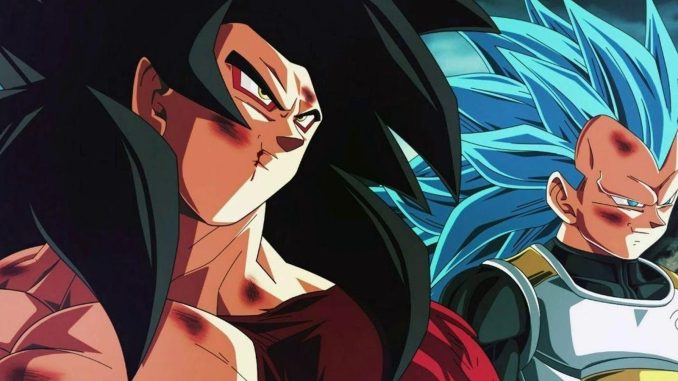
There are few TV shows with the kind of legacy and reputation of “Dragon Ball,” let alone shows that deserve that legacy. After all, for millions of people outside of Japan, “Dragon Ball” is essentially synonymous with the anime medium itself. For that matter, virtually every shonen action anime of the past 30 years has been influenced by Akira Toriyama’s creation, whether in tone, format, or simply character design.
Just how influential are “Dragon Ball” and its sequel “Dragon Ball Z?” So much so that the former, an anime that was inspired by Superman, is now inspiring the Man of Steel’s next live-action movie, with the trailer for James Gunn’s “Superman” sporting a reference to an iconic “Dragon Ball Z” character death.
Though the “Dragon Ball” franchise has never really gone away (right now, fans can enjoy the brand-new anime “Dragon Ball Daima”), there is one chapter in the franchise that is often either overlooked or forgotten. That would be “Dragon Ball GT,” the third installment in the property and one whose place in the canon (or lack thereof) is a frequent topic of discussion. So, whether you’re only just getting into the “Dragon Ball” franchise or doing a rewatch, here’s what you need to know about “Dragon Ball GT.”
What is Dragon Ball GT?
Barely a week after “Dragon Ball Z” came to an end in 1996, a new anime premiered, with “Dragon Ball GT” promising to explore the next chapter in Son Goku’s saga. In this story, Emperor Pilaf (the very first villain in the original series) manages to turn Goku into a child. He then teams up with his granddaughter Pan, as well as Trunks, and goes on a quest in search of the Black Star Dragon Balls, a wholly new set of Dragon Balls that are scattered throughout the galaxy.
The second half of “Dragon Ball GT” brings back most of the rest of the main cast of “Dragon Ball Z” as they face new threats. It also introduced the Super Saiyan 4 form, which combines the Super Saiyan power-up with the Great Ape form, in addition to hinting at the hypothetical strongest Super Saiyan form (Super Saiyan 5) and giving Vegeta his coolest form: a dad with a killer mustache.
Is Dragon Ball GT canon?
The short answer: “Dragon Ball GT” isn’t canon. The longer answer: It’s complicated, but it’s not still canon. The main reason the show is not considered canon is that it is not a work that originated from franchise creator Akira Toriyama, nor is it based on a manga series.
Admittedly, Toriyama never properly called “Dragon Ball GT” non-canon (because why would he?), referring to it instead as a “grand side-story” in the “Dragon Ball” universe. Nonetheless, his comment implies the show is either a non-canon story with no impact on the other “Dragon Ball” series or, at the very most, an alternate universe tale that takes place outside of the main “Dragon Ball” continuity.
What does complicate the matter is the fact that Shueisha, the publisher that owns “Dragon Ball,” has previously included “GT” in its official timeline, resulting in debates about the anime’s canonical status. There’s also the fact that, until “Dragon Ball Super” came out in 2015, “GT” was the very last “Dragon Ball” anime series, which made it all the easier to simply assume that it was part of the property’s canonical narrative. However, now that both “Dragon Ball Super” and especially the more recent “Dragon Ball Daima” have completely ignored the effects of “GT,” it’s all the more tempting and reasonable to simply treat the latter as non-canon.
When does Dragon Ball GT take place?
The timeline of “Dragon Ball GT” is also complicated, given its status. According to Shueisha, the series takes place at the very end of the “Dragon Ball” timeline, approximately five years after the “Peaceful World Saga” from the end of “Dragon Ball Z.” This is after the events of both “Daima” and “Dragon Ball Super,” which take place between the end of the “Majin Buu Saga” and the “Peaceful World Saga.”
Of course, the problem with this timeline is that we have gotten new anime since the end of “GT,” and absolutely no major event or character from either “Super” or “Daima” is referenced in “Dragon Ball GT.” Of course, neither of those shows have even been conceived when “GT” was airing, so it makes sense. Nevertheless, it doesn’t help the canonical case for “GT” that it is so absolutely standalone and unconnected from every other aspect of the franchise.
Was Akira Toriyama involved in Dragon Ball GT?
No, Akira Toriyama was not involved with “Dragon Ball GT.” He did, of course, have a hand in crafting many entries in the “Dragon Ball” anime franchise, coming up with concepts, characters, stories, and more. On both “Super” and “Daima,” Toriyama was likewise involved with both the writing process and character designs. Yet, when it comes to “Dragon Ball GT,” the only contribution Toriyama made was the title treatment and a few designs. However, he wasn’t involved in developing the story or its characters beyond that.
Granted, we likely have Toriyama to thank for Vegeta growing a mustache, but again, he otherwise had no involvement in “GT.” This is also the main reason why many fans don’t consider the series canon, seeing as it didn’t come from the mind of the property’s creator — and for a guy who tended to be as hands-on as Toriyama not to touch “GT,” it says something about how unconnected this anime is from everything else.
Does that make “GT” a lesser “Dragon Ball” series? Absolutely not. There’s still plenty to like and enjoy about it, with “Dragon Ball Daima” having referenced the show on multiple occasions. That being said, it’s best to treat “GT” the same way one does the “Dragon Ball” animated movies and filler episodes. They’re still part of the franchise, yes, but more like side-missions.

Leave a Reply